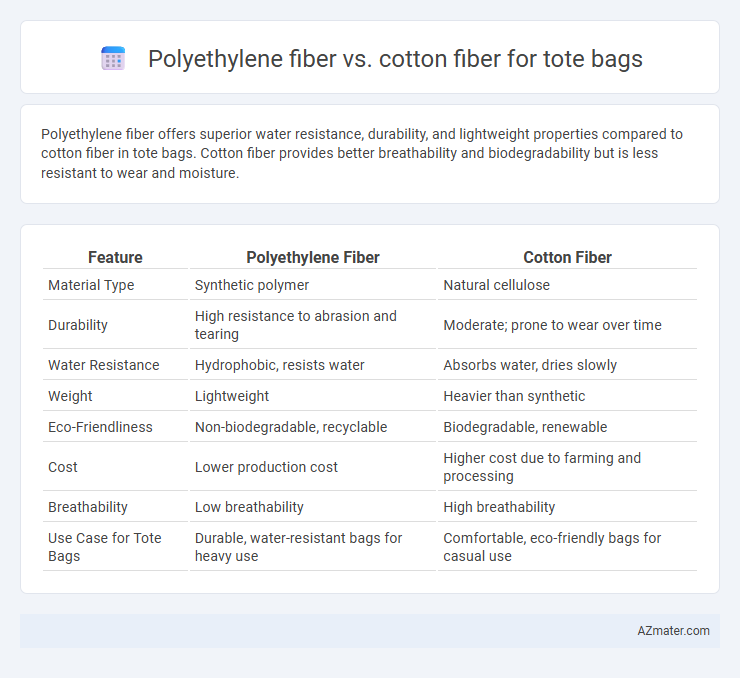Polyethylene fiber offers superior water resistance, durability, and lightweight properties compared to cotton fiber in tote bags. Cotton fiber provides better breathability and biodegradability but is less resistant to wear and moisture.
Table of Comparison
| Feature | Polyethylene Fiber | Cotton Fiber |
|---|---|---|
| Material Type | Synthetic polymer | Natural cellulose |
| Durability | High resistance to abrasion and tearing | Moderate; prone to wear over time |
| Water Resistance | Hydrophobic, resists water | Absorbs water, dries slowly |
| Weight | Lightweight | Heavier than synthetic |
| Eco-Friendliness | Non-biodegradable, recyclable | Biodegradable, renewable |
| Cost | Lower production cost | Higher cost due to farming and processing |
| Breathability | Low breathability | High breathability |
| Use Case for Tote Bags | Durable, water-resistant bags for heavy use | Comfortable, eco-friendly bags for casual use |
Introduction to Tote Bag Materials
Polyethylene fiber offers superior durability and water resistance compared to cotton fiber, making it a practical choice for tote bags intended for heavy or wet use. Cotton fiber provides a natural, biodegradable option with excellent breathability and softness, preferred for eco-friendly and fashion-forward tote bags. Evaluating tensile strength, environmental impact, and texture helps determine the ideal material for specific tote bag applications.
Overview of Polyethylene Fiber
Polyethylene fiber is a lightweight, durable, and water-resistant synthetic material commonly used for tote bags due to its high tensile strength and resistance to chemicals and abrasion. Its hydrophobic properties make it ideal for maintaining structural integrity in various weather conditions, unlike cotton fiber, which absorbs moisture and can weaken over time. Polyethylene fibers also offer better UV resistance and longer lifespan, making them a practical choice for eco-conscious consumers seeking durability and low maintenance.
Overview of Cotton Fiber
Cotton fiber, derived from the natural seed hairs of the cotton plant, is renowned for its softness, breathability, and biodegradability, making it a popular choice for tote bags. Its cellulose-based structure provides excellent moisture absorption and comfort, enhancing user experience while maintaining environmental sustainability. Compared to polyethylene fiber, cotton offers superior biodegradability and a renewable resource profile, although it may require more water and energy resources during cultivation and processing.
Environmental Impact: Polyethylene vs Cotton
Polyethylene fiber, derived from petrochemicals, is less biodegradable and can contribute to microplastic pollution, whereas cotton fiber, being natural and biodegradable, decomposes more easily and has a lower long-term environmental footprint. However, cotton cultivation requires significant water, pesticide, and land use, leading to deforestation and soil degradation concerns. Choosing between polyethylene and cotton for tote bags involves weighing the trade-offs between synthetic fiber pollution and the resource-intensive nature of natural fiber production.
Durability and Strength Comparison
Polyethylene fiber offers superior durability and tensile strength compared to cotton fiber, making it ideal for heavy-duty tote bags designed to carry substantial weight. Its resistance to abrasion, moisture, and UV degradation ensures long-lasting performance in various environmental conditions. Cotton fiber, while breathable and biodegradable, lacks the robust tensile properties and wear resistance found in polyethylene, resulting in bags that may wear out more quickly under frequent or heavy use.
Weight and Portability Differences
Polyethylene fiber offers significantly lower weight compared to cotton fiber, making tote bags crafted from polyethylene much lighter and easier to carry. The lightweight nature of polyethylene enhances portability, allowing bags to be compactly folded without adding bulk. Cotton fiber bags, while durable, tend to be heavier and bulkier, which can reduce convenience for on-the-go use.
Water Resistance and Maintenance
Polyethylene fiber offers superior water resistance compared to cotton fiber, making tote bags highly resistant to moisture and ideal for wet or humid conditions. Maintenance of polyethylene fiber tote bags is simpler, as they can be easily wiped clean without the need for frequent washing, unlike cotton fibers that absorb water and require regular laundering to prevent mold and odors. Cotton fibers provide natural breathability but demand more effort to maintain water resistance and drying, impacting durability and overall care.
Cost and Affordability Analysis
Polyethylene fiber offers a cost-effective alternative to cotton fiber for tote bags, with manufacturing expenses typically 30-50% lower due to its synthetic production process. Cotton fibers require extensive agricultural resources and labor, resulting in higher raw material costs and price volatility influenced by climate conditions. For budget-conscious consumers or mass production, polyethylene fiber provides greater affordability without compromising basic durability.
Aesthetic and Design Flexibility
Polyethylene fiber offers superior aesthetic appeal for tote bags with a smooth, glossy finish that supports vibrant, fade-resistant prints, enhancing design versatility. Cotton fiber provides a natural, matte texture that complements earthy, rustic designs but may limit intricate print clarity due to its porous surface. The synthetic nature of polyethylene enables greater color retention and sharper graphics, while cotton's breathable quality favors organic and vintage-themed aesthetics.
Which Fiber is Best for Tote Bags?
Polyethylene fiber offers superior durability, water resistance, and lightweight properties compared to cotton fiber, making it ideal for tote bags that require long-lasting use and easy cleaning. Cotton fiber provides natural breathability and a soft texture, appealing to eco-conscious consumers seeking biodegradability and comfort. For tote bags prioritizing strength, moisture resistance, and longevity, polyethylene fiber is generally the best choice.

Infographic: Polyethylene fiber vs Cotton fiber for Tote bag
 azmater.com
azmater.com